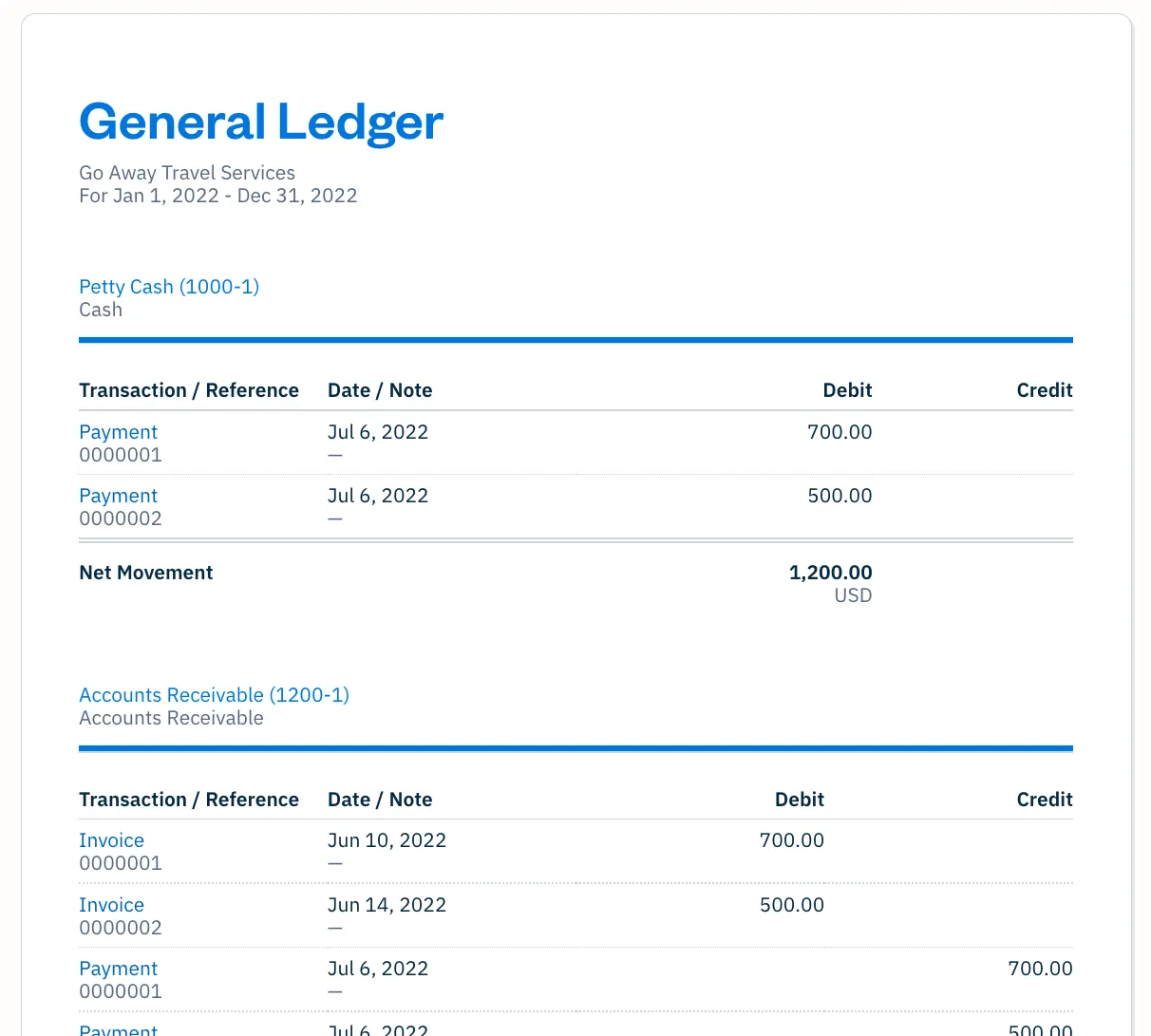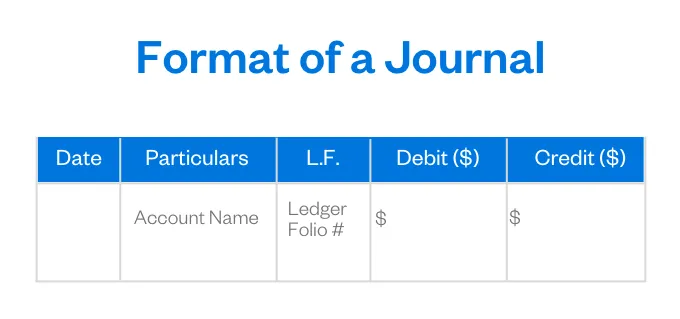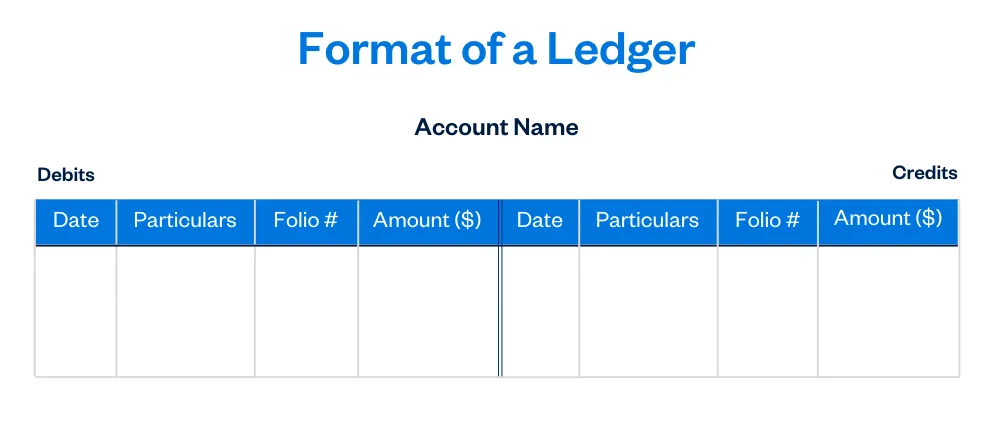Ledger in accounting: Process, example & free template

A ledger is a book or digital record containing bookkeeping entries. Ledgers may contain detailed transaction information for one account, one type of transaction, or—in the case of a general ledger—summarized information for all of a company’s financial transactions over a period.
Ledgers are also known as the second book of entry.
Ledgers contain the necessary information to prepare financial statements.
Key takeaways
- A ledger is a book or digital record that stores bookkeeping entries, categorizing and recording all financial transactions.
- The ledger shows the account’s opening balance, all debits and credits to the account for the period, and the ending balance.
- Common types of ledger accounts include general ledger, asset accounts, liability accounts, equity accounts, revenue accounts, and expense accounts.
- The general ledger is the master collection of all ledger accounts, providing a comprehensive summary of all your business’s financial activities.
- Ledgers are essential for preparing financial statements, tracking spending, compiling a trial balance, and spotting unusual transactions.
- In the double-entry bookkeeping method, financial transactions are initially recorded in the journal and then posted to the ledger.
- Accounting software, like FreshBooks, can simplify the process of recording transactions and maintaining accurate ledgers.
Table of contents
- What is a ledger in accounting?
- What is a ledger account?
- How bookkeepers use ledger accounts
- General ledger example
- What’s the difference between a journal and a ledger?
- Simplify ledger management with FreshBooks
What is a ledger in accounting?
In accounting, a ledger is a book or digital file that stores bookkeeping entries, categorizing and recording all financial transactions. It’s a core component of the accounting process, providing a structured way to track and analyze financial information.
The ledger shows the account’s opening balance, all debits and credits to the account for the period, and the ending balance. The ledger is essentially a collection of individual accounts, each representing a specific type of financial activity, like assets, liabilities, or expenses. Companies can maintain ledgers for all types of balance sheet and income statement accounts, including accounts receivable, accounts payable, sales, and payroll. Transactions from subsidiary ledgers are periodically summarized and transferred to the general ledger, which contains transaction data for all accounts in the chart of accounts.
Preparing a ledger is important as it serves as a master document for all your financial transactions. Since it reports revenue and expenses in real-time, it can help you stay on top of your spending. The general ledger also helps you compile a trial balance, spot unusual transactions, and create financial statements.
What is a ledger account?
A ledger account is a record of all transactions affecting a particular account within the general ledger. Individual transactions are identified within the ledger account with a date, transaction number, and description to make it easier for business owners and accountants to research the reason for the transaction.
Here are some of the most common types of ledger accounts:
- General ledger: This is the master collection of all ledger accounts, providing a comprehensive summary of all your business’s financial activities.
- Asset accounts: These accounts track all resources owned by your business, including cash, property, machinery, accounts receivable, and inventory.
- Liability accounts: These accounts record obligations and debts that your business owes to others, such as loans payable and accounts payable.
- Equity accounts: These accounts reflect the owner’s investment in the business, including capital and retained earnings.
- Revenue accounts: These accounts track income earned from your business operations, such as sales revenue and service income.
- Expense accounts: These accounts record costs incurred in generating revenue, such as rent expense, utilities expense, salaries, and taxes.
Check out the post “Maintaining a General Ledger” from Wolters Kluwer for a more extensive list of general ledger accounts that might apply to medium to large businesses.
How bookkeepers use ledger accounts
The company’s bookkeeper records transactions throughout the year by posting debits and credits to these accounts. The transactions result from normal business activities such as billing customers or purchasing inventory. They can also result from journal entries, such as recording depreciation.
The ledger might be a written record if the company does its accounting by hand or electronic records when it uses accounting software. According to CPA Practice Advisor, only 18% of small- to medium-sized businesses do not use accounting software.
How do you write an accounting ledger?
Most businesses use accounting software that posts all financial transactions directly to the general ledger. However, if you want to create your own general ledger, you’ll first need to understand the basics of double-entry bookkeeping.
In the double-entry system, each financial transaction affects at least 2 different ledger accounts. Each entry is recorded in two columns, with debit postings on the left and credit entries on the right of the ledger. The total of all debit and credit entries must balance.
Here is how to create your ledger and put it to use:
Step 1: Set up ledger accounts
Start with the 5 account types: Assets, Liabilities, Equity, Revenue, and Expenses (and perhaps Other Income and Expenses). Within each account type, list the accounts you need. For example, under the Asset account type, you’ll create a Cash account and an Accounts Receivable account.
Step 2: Create columns
Make columns on the far left of the page for the date, transaction or journal entry number, and description.
Make columns on the right side for debits, credits, and running balance. Debits increase asset and expense accounts and decrease liability, revenue, and equity accounts. Credits increase liability, revenue, and equity accounts and reduce assets and expenses.
Step 3: Record financial transactions
Day-to-day, record your business transactions as they occur. If you’ve made a journal entry, post it to the ledger immediately.
Step 4: Create a trial balance
Summarize the ending balances from the general ledger and present account level totals to create your trial balance report. The trial balance totals are matched and used to compile financial statements.
General ledger example
Following is an example of a general ledger report from FreshBooks. It shows all of the activity for accounts receivable for the month of April, including debits and credits to the general ledger account and the net change to the account for the month.

Check out this downloadable general ledger template if you want to create your own general ledger.
What’s the difference between a journal and a ledger?
Both the accounting journal and ledger play essential roles in the accounting process. Bookkeepers primarily record transactions in a journal, also known as the original book of entry.
After that, the bookkeepers can post transactions to the correct subsidiary ledgers or the proper accounts in the general ledger. While many financial transactions are posted in both the journal and ledger, there are significant differences in the purpose and function of each of these accounting books.
Ledger meaning vs. journal meaning in accounting
In the double-entry bookkeeping method, financial transactions are initially recorded in the journal. It’s also known as the primary book of accounting or the book of original entry. The journal must include detailed descriptions for every transaction.
On the other hand, the ledger is the second book of entry because it has summarized information from the journal in the “T-account” format. It is used to create the trial balance, which is also the source of financial statements such as the income statement and the balance sheet.
Recording transactions
Journalizing is the process of recording transactions in a journal as journal entries. Posting is the process of transferring the all the transactions to the ledger.
Journal entries are recorded in chronological order, making it easy to identify the transactions for a given business day, week, or another billing period. By contrast, entries in a ledger might group like transactions into specific accounts to assess the data for internal financial and accounting purposes.
Transactions that occur frequently—such as revenues, cash receipts, purchases, and cash payments—are typically recorded as journal entries first.
Format
A journal format is simple. It includes the transaction date, particulars of the transaction, folio number, debit amount, and credit amount. There’s no need to balance journal entries.

The ledger uses the T-account format, where the date, particulars, and amount are recorded for both debits and credits.

Ledger accounts almost always start out with an opening balance. For balance sheet accounts, the opening balance is usually the closing balance from the previous period. Income statement accounts start with an opening balance of zero because revenues and expenses should have been closed to retained earnings at the end of the prior period. At the end of the period, all ledger amounts should balance. In other words, debts must equal credits.
Preparing a ledger is vital because it serves as a master document for all your financial transactions. Since it reports revenue and expenses in real-time, it can help you stay on top of your spending. The general ledger also enables you to compile a trial balance and helps you spot unusual transactions and create financial statements.
Using a ledger, you can maintain an accurate record of your business’s financial transactions, generate financial reports, and monitor business results.
But you don’t have to be intimately acquainted with journals and ledgers to keep tabs on the financial health of your business.
Simplify ledger management with FreshBooks
While a solid understanding of ledgers and their role in accounting is crucial for any business, the day-to-day management of ledgers doesn’t have to be a complex or time-consuming chore. FreshBooks accounting software is designed to simplify and streamline how small businesses and self-employed professionals handle their financial records, freeing up valuable time to focus on core business operations.
FreshBooks empowers you to move away from manual ledger entries and spreadsheets, automating key accounting tasks and ensuring accuracy. With FreshBooks, you can:
- Effortlessly record transactions: Automatically record income and expenses, eliminating manual data entry and reducing the risk of errors. This ensures your ledger is always up-to-date and accurate.
- Gain real-time financial insights: Easily track income, expenses, and profitability, providing a clear and instant view of your business’s financial health. This enables you to make informed decisions based on real-time data.
- Generate key financial reports: Create essential financial reports, including balance sheets, income statements, and trial balances, with just a few clicks. This simplifies financial reporting and ensures you have the necessary documents for tax preparation and business analysis.
- Collaborate seamlessly with your accountant: Share access to your FreshBooks account with your accountant, making collaboration and financial oversight easier than ever. This feature ensures smooth communication and simplifies the process of preparing financial statements and tax returns.
By leveraging FreshBooks, you can minimize the time spent on ledger management and accounting administration, and maximize the time dedicated to growing your business. Its intuitive interface, robust features, and automation capabilities empower you to maintain accurate financial records, gain valuable insights into your business performance, and ensure compliance, all within a user-friendly platform.
Reviewed by
Janet Berry-Johnson, CPA, is a freelance writer with over a decade of experience working on both the tax and audit sides of an accounting firm. She’s passionate about helping people make sense of complicated tax and accounting topics. Her work has appeared in Business Insider, Forbes, and The New York Times, and on LendingTree, Credit Karma, and Discover, among others. You can learn more about her work at jberryjohnson.com.
RELATED ARTICLES


 What Is Accounting? The Basics, Explained
What Is Accounting? The Basics, Explained What Is Management Accounting?
What Is Management Accounting? What Are Liquid Assets? A Primer for Small Businesses
What Are Liquid Assets? A Primer for Small Businesses Allowance for Doubtful Accounts: Deduction Technique Explained
Allowance for Doubtful Accounts: Deduction Technique Explained Closing the Books: Basics & 8 Steps Guide
Closing the Books: Basics & 8 Steps Guide  When Should I Hire an Accountant
When Should I Hire an Accountant